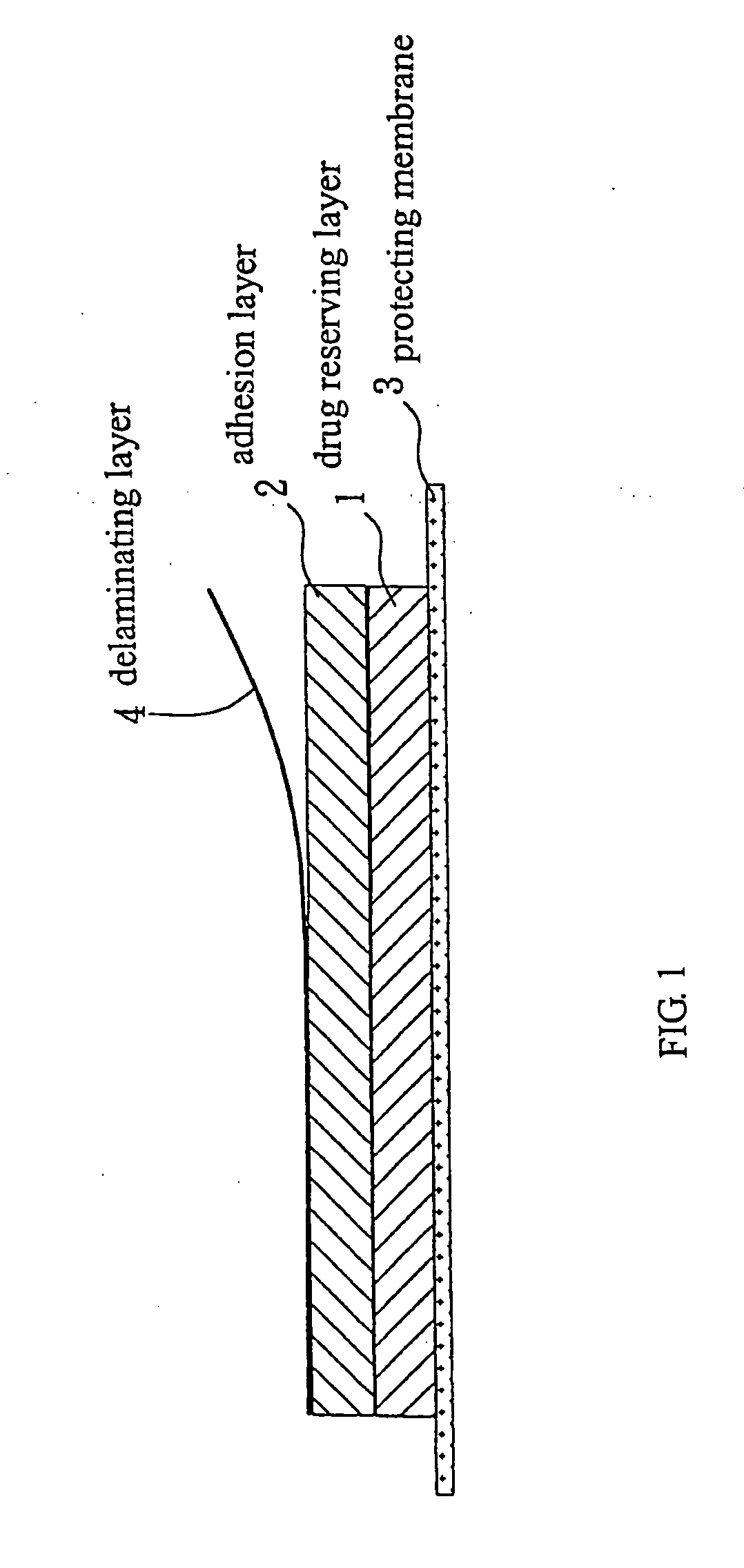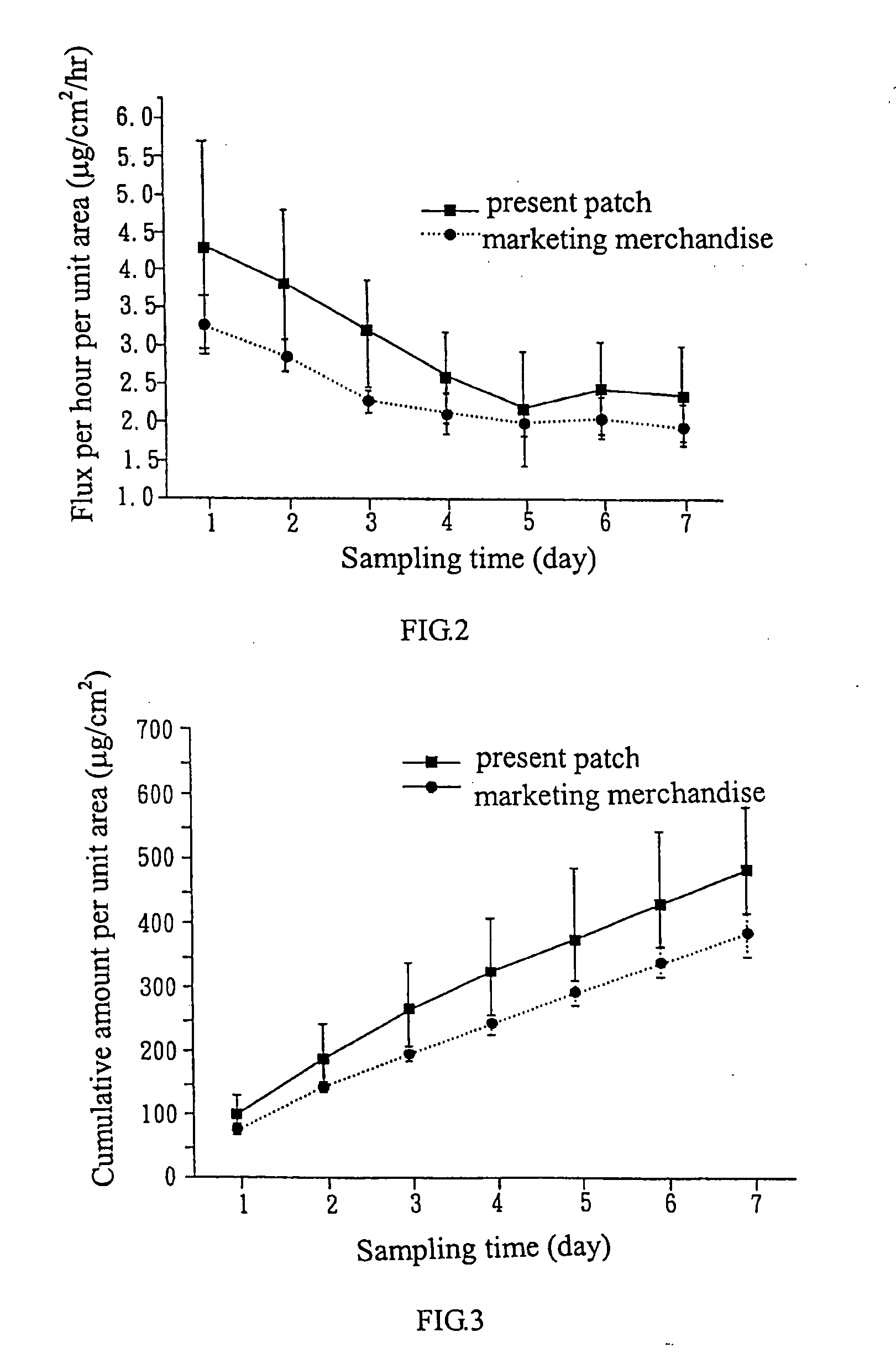Transdermal patch for long-term steady release
a technology of patch and steady release, applied in the field of transdermal patch, can solve the problems of unfavorable commercialization, increase the cost and preparation process, and irritation of the gastrointestinal tract, and achieve the effect of long-term steady release of drugs
- Summary
- Abstract
- Description
- Claims
- Application Information
AI Technical Summary
Benefits of technology
Problems solved by technology
Method used
Image
Examples
embodiment 1
Step 1 Gel Preparation
[0021] A 9%-wt of Oppanol B-100 (BASF Company; polyisobutenes with molar mass of 250,000) and a 12%-wt of Oppanol B-10 (BASF Company; polyisobutenes with molar mass of 24,000) are placed in a 5L stirring tank. Cyclohexane is added as a solvent and stir for one day, and then the mixture is moved to the rolling mixer for rolling another one day to produce a transparent gel, namely Oppanol B gel.
Step 2 Mixing of the R Layer / A Layer Formulation
[0022] The formulation comprises the R layer (drug reservior layer) mixing process and the A layer (adhesion layer) mixing process.
1. R Layer Mixing Process:
[0023] A 0.5%-wt of silicone dioxide is added to a 39%-wt of light mineral oil, and then the mixture is shaken with Vortex until an emulsion is presented. Then, a 110%-wt of clonidine material is added to the mixture for further shaking with Vortex. After an emulsion is presented, the mixture is mixed for 24 hrs in the rolling mixer. The 50.5%-wt of Oppanol B gel ...
embodiments 2 to 4
[0032] Based on steps 1 to 5 of the embodiment 1 in the present invention, embodiments 2 to 4 change the R layer (the drug reservior layer) and the A layer (the adhesion layer) formulation in the step 2 mixing process and are described as weight percentage in the following Table 1.
TABLE 1The formulation of embodiments 2 to 4Formulation with additive\%-wtEmbodiment 2Embodiment 3Embodiment 4R layerDrugClonidine9.49.49.4componentExcipientLight Mineral40.337.335.3OilOppanol B gel50.350.350.3SiO2—35A layerDrugClonidine2.82.82.8componentExcipientLight Mineral54.151.149.1OilOppanol B gel43.143.143.1SiO2—35
embodiments 5 to 10
[0033] Based on steps 1 to 5 of embodiment 1 in the present invention, embodiments 5 to 10 change the R layer (the drug reservior layer) and the A layer (the adhesion layer) formulation in the step 2 mixing process and are described as weight percentage in the following Table 2.
TABLE 2The formulation of embodiments 5 to 10Formulation with additive\Embodiment%-wtEmbodiment 5Embodiment 6Embodiment 7Embodiment 8Embodiment 910RDrugClonidine9.09.09.09.09.09.0layercomponentExcipientLight25.837.837.8———MineralOil10%13.0—————TPGSCoster———38.8——5024Coster————38.8—5088Larrafil—————38.8M 1944CSOppanol52.252.252.252.252.252.2B gel1% Span—1.0————801% PEG1.0———400Clonidine9.09.09.09.09.09.0ADrugClonidine2.72.72.72.72.72.7layercomponentExcipientLight34.951.451.4———MineralOil10%17.5—————TPGSCoster———52.4——5024Coster————52.4—5088Larrafil—————52.4M 1944CSOppanol44.944.944.944.944.944.9B gel1% Span—1.0————801% PEG——1.0———400Clonidine2.72.72.72.72.72.7
Wherein:
TPGS: vitamin E derivative (alpha-tocoph...
PUM
| Property | Measurement | Unit |
|---|---|---|
| temperature | aaaaa | aaaaa |
| temperature | aaaaa | aaaaa |
| temperature | aaaaa | aaaaa |
Abstract
Description
Claims
Application Information
 Login to View More
Login to View More - R&D
- Intellectual Property
- Life Sciences
- Materials
- Tech Scout
- Unparalleled Data Quality
- Higher Quality Content
- 60% Fewer Hallucinations
Browse by: Latest US Patents, China's latest patents, Technical Efficacy Thesaurus, Application Domain, Technology Topic, Popular Technical Reports.
© 2025 PatSnap. All rights reserved.Legal|Privacy policy|Modern Slavery Act Transparency Statement|Sitemap|About US| Contact US: help@patsnap.com



